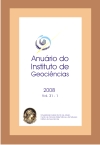The genus Pholadomya Sowerby, 1823 (Mollusca: Bivalvia) of Jandaíra formation (Late Cretaceous), Potiguar Basin: paleoecological and paleogeographic implications
DOI:
https://doi.org/10.11137/2008_1_88-97Abstract
Pholadomya Sowerby, 1823 is an anomalodesmatan bivalve that dispersed during Mesozoic, like other Mollusks, colonizating the South Atlantic shallow seas, between Brazil and Africa. On brazilian Cretaceous the sources of Pholadomya are scarce, occurring in outcrops from Algodões Formation, Gramame Formation and Jandaíra Formation, where occurs the species Pholadomya baixaleitensis. Based on specimens from new outcrops of Jandaíra Formation, a new occurrence of P. cf. adversa and P. baixaleitensis are shown and a new morfotype for the genus is described. It was possible to infer that the species studied presented deep endobentonic habits, and burrowed slowly the sediment, probably living their whole life into the same cavity. During Campanian Pholadomya is known from Cameroon, France, Poland, Austria, Germany and other localities in United States of America, occurring in association with other tethyan mollusks. The records of the genus in the marginal equatorial basins enhance the fossil bivalve diversity, and agree with the hypotesis of a south latitudinal range for the Tethyan Realm during Upper Cretaceous.Downloads
Download data is not yet available.
Downloads
Published
2008-01-01
How to Cite
Benaim, N. P. and Senra, M. C. E. (2008) “The genus Pholadomya Sowerby, 1823 (Mollusca: Bivalvia) of Jandaíra formation (Late Cretaceous), Potiguar Basin: paleoecological and paleogeographic implications”, Anuário do Instituto de Geociências. Rio de Janeiro, BR, 31(1), pp. 88–97. doi: 10.11137/2008_1_88-97.
Issue
Section
nd1569639953
License
This journal is licensed under a Creative Commons — Attribution 4.0 International — CC BY 4.0, which permits use, distribution and reproduction in any medium, provided the original work is properly cited.















